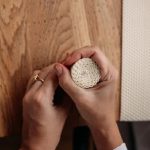When making candles, why does the top sink? Sinkholes in homemade candles are a common issue that many candle-makers often encounter. These unsightly indentations can be frustrating and take away from the overall aesthetic of the candle. In this article, we will explore the reasons behind sinkholes in homemade candles, as well as provide tips and solutions for preventing and fixing them.
Understanding the science behind candle-making is essential for addressing the issue of sinkholes. By delving into the scientific process of how candles are made, we can better comprehend why sinkholes occur and how to avoid them. From choosing the right wax to proper wick placement and temperature control, each aspect of the candle-making process plays a crucial role in preventing sinkholes.
In addition to understanding the science, selecting the right wax is vital in preventing sinkholes. Different types of wax impact the formation of sinkholes differently, and by choosing the appropriate wax for your specific candle-making needs, you can potentially reduce or eliminate sinkholes altogether. Temperature control during the pouring process also plays a significant role in preventing uneven surfaces on your homemade candles. Understanding these key factors will help address and prevent sinkholes when making candles at home.
Understanding the Science
When making candles, it is not uncommon to encounter the frustrating issue of sinkholes forming on the top of the candle. Sinkholes are small indentations that can appear as the candle wax cools, and they can detract from the overall appearance of the finished product. Understanding why sinkholes occur is important in order to prevent this issue when making candles at home.
The formation of sinkholes in candles is primarily due to the natural properties of wax and how it behaves during the cooling process. As the molten wax cools and solidifies, it shrinks slightly, creating empty pockets within the candle. These empty pockets manifest as sinkholes on the surface. Additionally, if air becomes trapped within the wax as it solidifies, this can also lead to sinkholes forming on the top of the candle.
Choosing the right type of wax for candle-making is essential in preventing sinkholes from occurring. Some types of wax are more prone to shrinkage and air entrapment than others, which can increase the likelihood of sinkholes developing in your homemade candles.
Beeswax, for example, has a higher melting point than soy wax and paraffin wax, making it less prone to shrinkage and air entrapment. Therefore, selecting a wax with properties that minimize these issues can help reduce the occurrence of sinkholes in your candles.
| Types of Wax | Sinkhole Occurrence |
|---|---|
| Beeswax | Less prone to shrinkage and air entrapment |
| Soy Wax | More prone to shrinkage and air entrapment |
| Paraffin Wax | Varies depending on quality |
Choosing the Right Wax
When making candles, the type of wax used can greatly impact the likelihood of sinkholes forming on the top of the candle. Different types of wax have different properties that can affect how the candle burns and solidifies, leading to sinkholes if not chosen carefully.
Paraffin Wax
Paraffin wax is one of the most common types of wax used in candle-making. However, paraffin wax has a tendency to shrink as it cools, which can result in sinkholes forming on the top of the candle. To prevent this from happening, it is important to choose a high-quality paraffin wax with additives specifically designed to reduce shrinkage and sinkholes.
Soy Wax
Soy wax is known for its clean-burning properties and is a popular choice for environmentally-conscious candle makers. However, soy wax also has a tendency to develop sinkholes when it solidifies due to its natural characteristics. Adding stearic acid or vybar to soy wax can help reduce the occurrence of sinkholes and improve the overall finish of the candle.
Beeswax
Beeswax is another commonly used wax in candle-making and offers a natural, sweet scent when burned. However, beeswax has a high melting point and can be prone to developing sinkholes if not properly managed during the cooling process. It is important to use a double boiler method when melting beeswax and pour at an optimal temperature to prevent sinkholes from forming.
Ultimately, choosing the right type of wax and understanding its properties is crucial in preventing sinkholes from forming on homemade candles. By selecting high-quality waxes and taking appropriate measures during the cooling process, candle makers can minimize the risk of sinkholes and ensure a flawless finish for their candles.
Proper Wick Placement
When making candles, one of the crucial factors that can impact the formation of sinkholes is the placement of the wick. The wick serves as the channel through which the melted wax is drawn up to fuel the flame. Improper wick placement can lead to uneven burning and result in sinkholes.
Importance of Centering the Wick
It is essential to ensure that the wick is centered within the container when pouring the wax. If the wick is not in the center, it can cause uneven distribution of heat, leading to sinkholes forming on one side of the candle. To prevent this, use a wick centering device or carefully adjust the wick position during and immediately after pouring.
Choosing the Right Size Wick
The size of the wick also plays a significant role in preventing sinkholes. Using a wick that is too small may not create enough heat to fully melt and distribute the wax, resulting in sinkholes. Conversely, a wick that is too large can cause excessive heat, leading to uneven melting and potential sinkhole formation. It’s important to match the size of the wick with the diameter of your candle container for optimal burn performance.
Trim and Maintain Wick Length
Trimming and maintaining the length of your candle’s wick is another important aspect when it comes to preventing sinkholes. A longer-than-necessary wick can produce a larger flame that melts more wax than necessary, potentially leading to a depression around the wick as it burns down.
Regularly trim your candle’s wick before each use to ensure proper burning and minimal risk of sinkhole formation. Paying attention to these factors when placing your candle’s wick can help prevent sinkholes from forming and ensure a beautiful, even burn every time you light your homemade candles.
Temperature Control
When making candles, it is common for the top to sink, leaving an undesirable hole in the center. This issue, known as sinkholes, can be frustrating for candle makers but can be avoided with the right techniques. One important factor to consider when making candles is temperature control during the candle-making process.
Temperature control plays a crucial role in preventing sinkholes in homemade candles. When the wax is poured at too high of a temperature, it can lead to sinkholes as the wax cools and contracts.
To avoid this, it is important to use a thermometer to monitor the temperature of the wax before pouring it into the container. Different types of wax have different melting and pouring temperatures, so it’s essential to follow the specific instructions for the type of wax being used.
One simple technique for controlling temperature during candle-making is to use a double boiler method to melt the wax gently and evenly. This helps ensure that the wax reaches the optimal pouring temperature without overheating. Additionally, allowing the melted wax to cool slightly before pouring can also help prevent sinkholes from forming on the top of the candle.
Another tip for controlling temperature and preventing sinkholes is to create a draft-free environment while the candles are setting. Sudden changes in temperature can cause uneven cooling and lead to sinkholes forming on top of the candles. By keeping an even temperature and avoiding drafts, you can help ensure that your homemade candles come out smooth and even on top.
| Temperature Control Tips | Effect |
|---|---|
| Use a thermometer to monitor wax temperature | Prevents overheating and sinkholes |
| Double boiler method for gentle melting | Evenly melts wax without overheating |
| Create draft-free environment while setting | Prevents sudden changes in temperature leading to sinkholes |
Avoiding Overpouring
When making candles, it is crucial to avoid overpouring the wax as it can lead to the formation of sinkholes. Sinkholes are a common issue in homemade candles and can greatly affect their appearance and quality. Overpouring occurs when too much liquid wax is poured into the candle container, causing the top of the candle to sink as it cools. This can result in an uneven surface and affect the overall burn of the candle.
To avoid overpouring and prevent sinkholes from forming, follow these tips:
1. Measure the wax: Use a scale to accurately measure the amount of wax needed for your specific candle container. Be sure to account for any added fragrance or colorants in your measurements.
2. Use a pouring pitcher: A pouring pitcher with a spout makes it easier to control the flow of wax into the candle container, reducing the likelihood of overpouring.
3. Leave room for expansion: When pouring the wax into the container, be sure to leave some space at the top to allow for any potential expansion during cooling. This extra space will help prevent sinkholes from forming as the wax solidifies.
By following these tips and being mindful of not overpouring the wax, you can help prevent sinkholes from forming in your homemade candles, resulting in a more professional-looking and high-quality finished product.
Troubleshooting Sinkholes
Sinkholes in candles are a common issue that many candle makers encounter, but the good news is that they can be fixed. Here are some solutions for fixing sinkholes in candles that have already formed:
1. Fill the Sinkhole: One solution for fixing sinkholes in candles is to fill the depression with more melted wax. Use a small spatula or spoon to pour the wax carefully into the sunken area, filling it until it’s level with the rest of the candle surface. Be sure to match the color and scent of the existing candle wax for a seamless finish.
2. Use Heat Gun or Hair Dryer: Another method to fix sinkholes in candles is to use a heat gun or hair dryer to gently warm up the surface of the candle. This will cause the top layer of wax to melt slightly and self-level, smoothing out any depressions. Be careful not to overheat the candle, as this could cause other issues such as cracking or melting.
3. Melt and Remake: If all else fails, you may need to melt down the entire candle and start over. By remelting the wax and pouring it into a new container with proper temperature control and wick placement, you can avoid forming sinkholes in your new candle.
By following these troubleshooting solutions, you can fix sinkholes in candles that have already formed and achieve a professional-looking final product when making candles why does the top sink.
Conclusion
In conclusion, sinkholes in homemade candles can be a frustrating issue for many candle makers. However, by understanding the science behind candle-making and implementing the right techniques, it is possible to prevent sinkholes from forming.
One of the key factors that can lead to sinkholes is the type of wax used, so choosing the right wax for your candles is crucial. Different waxes have different melting points and characteristics that can impact how well they hold up during the cooling process, ultimately affecting whether or not sinkholes form.
Proper wick placement and temperature control are also essential in preventing sinkholes. Placing the wick in the center of the container and ensuring that the temperature is carefully monitored during the cooling process can make a significant difference in the final outcome of your candles. Additionally, avoiding overpouring and using just the right amount of wax can help prevent sinkholes from forming.
When making candles why does the top sink The good news is that should sinkholes still occur despite these preventative measures, there are troubleshooting methods available to fix them. By following these tips and being mindful of each step in the candle-making process, you can increase your chances of creating beautiful, high-quality candles that are free from unsightly sinkholes.
Frequently Asked Questions
How Do You Prevent Sinkholes in Candles?
Preventing sinkholes in candles can be achieved by ensuring that the wax is poured at the right temperature and that it cools gradually. Using a heat gun to smooth out any sinkholes can also help.
Why Is My Homemade Candles Sinking?
Homemade candles may sink due to various reasons such as rapid cooling, poor quality wax, or not properly heating the container before pouring the wax. It’s important to troubleshoot these factors to prevent sinking.
How Do You Fix a Sunken Candle?
To fix a sunken candle, you can use a heat gun to gently warm the surface of the candle and fill in the sinkhole with additional melted wax. It’s important to do this carefully to maintain the aesthetic of the candle.

Welcome to my candle making blog! In this blog, I will be sharing my tips and tricks for making candles. I will also be sharing some of my favorite recipes.





